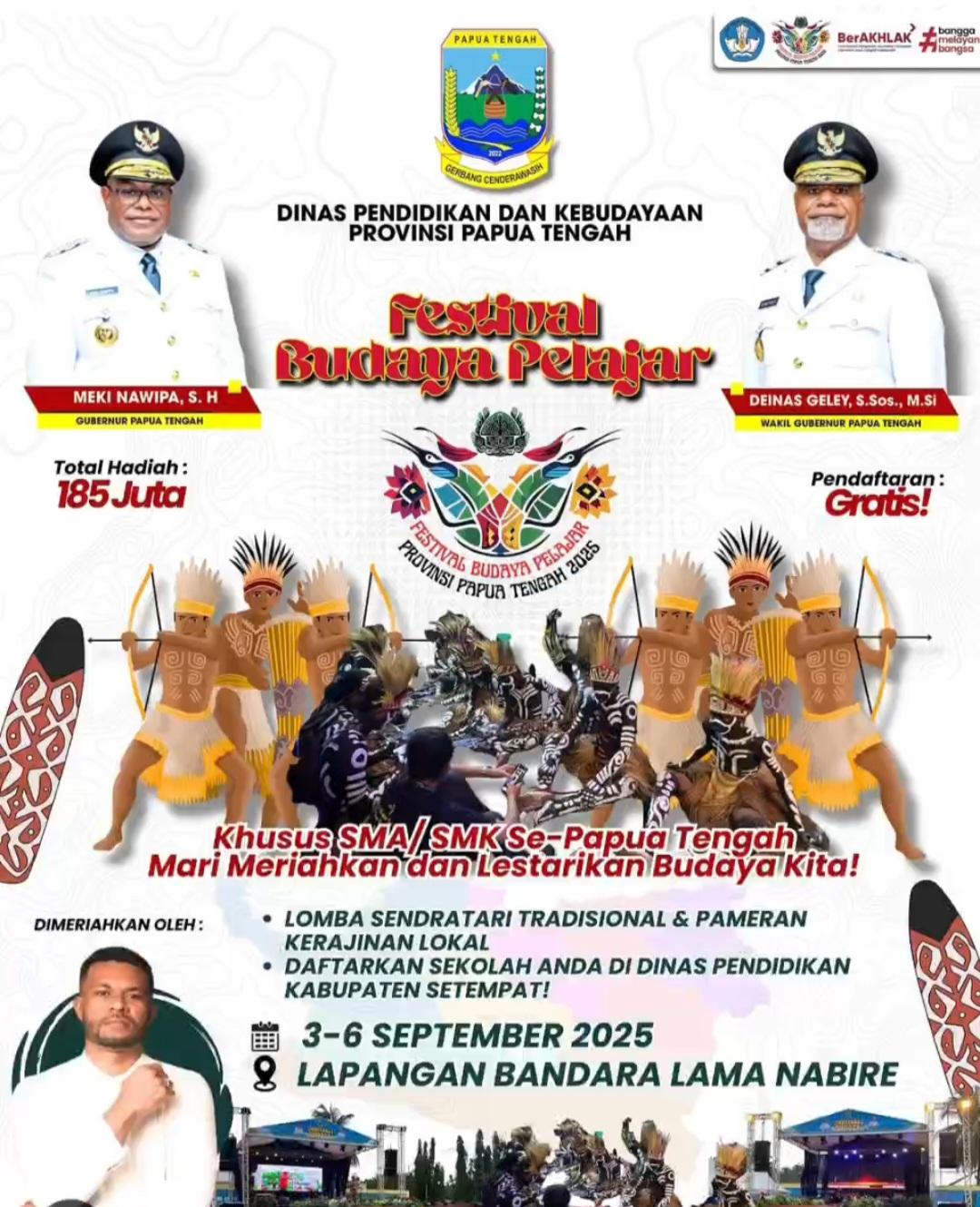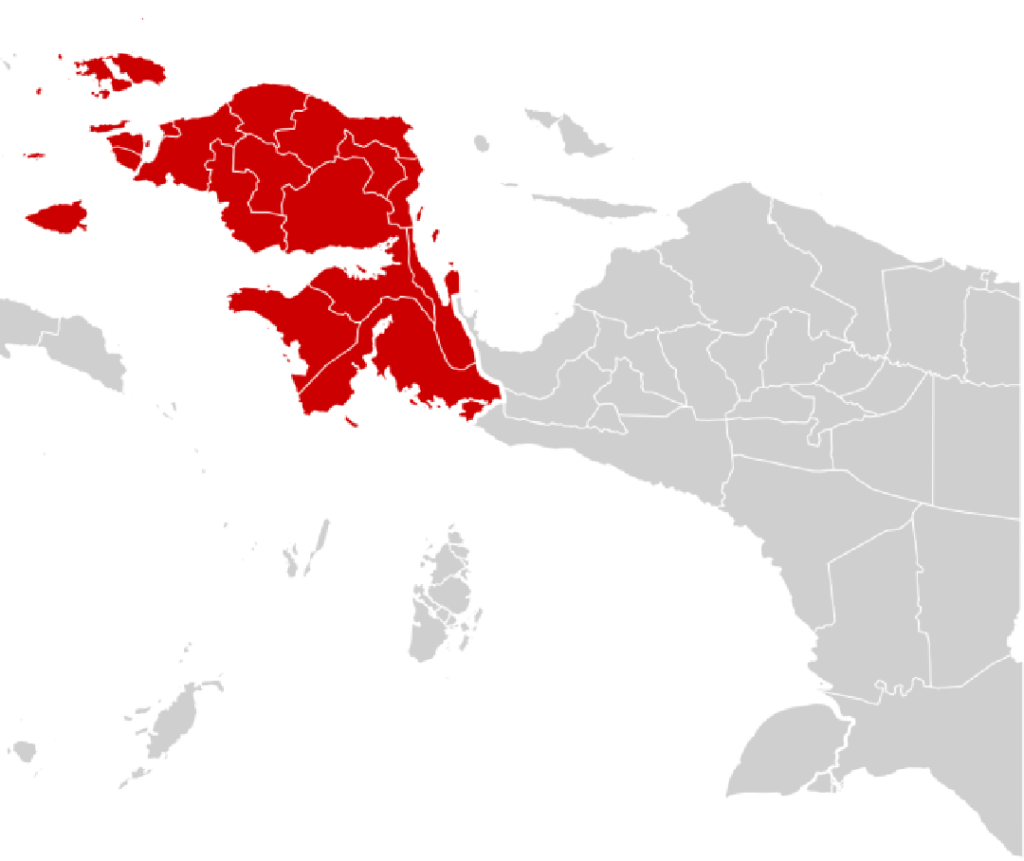As the sun dipped below the lush highlands of Papua Tengah, a rhythmic echo of drums and chanting filled the open air near the old Nabire Airport. For the first time in history, students from all eight regencies of Central Papua had gathered not for sports, exams, or politics—but for something deeper: the inheritance of their ancestors.
With traditional costumes billowing in the breeze, handmade ornaments glittering in the twilight, and young dancers moving in unified, ancestral rhythms, the Festival Budaya Pelajar se-Papua Tengah came alive—not just as a spectacle, but as a powerful cultural statement.
A Cultural Awakening Rooted in Youth
In an era of globalization, where traditional practices are often sidelined in favor of modernity, the Central Papua provincial government has launched a timely initiative—one that not only celebrates cultural diversity but intentionally places youth at its core. The Student Cultural Festival of Papua Tengah, which debuted on September 3, 2025, is more than an event; it’s a growing movement.
Held over four days, from September 3 to 6, this festival is part of a broader vision to preserve and revitalize local cultural identities—particularly those at risk of being forgotten. What makes this festival unique is not just its scale but also its soul: young people are not passive spectators; they are the main actors.
“Culture is not just what we inherit—it’s what we choose to carry forward. And who better to carry it forward than our youth?” said Nurhaidah Meki Nawipa, Acting Head of the Central Papua Office of Education and Culture, during the opening ceremony.
Uniting Eight Regencies for a Shared Cultural Mission
This year’s festival was groundbreaking for its full regional inclusion. Students from eight regencies—Nabire, Mimika, Paniai, Dogiyai, Deiyai, Intan Jaya, Puncak, and Puncak Jaya—participated, marking the first time a provincial cultural initiative brought together the entire administrative territory of Papua Tengah. Each region sent:
- 20 students to perform regional dances
- 2 students to present traditional crafts
- 3 supervisors to support the delegation
This totaled nearly 200 participants, converging in Nabire to celebrate the rich cultural tapestry of the region.
For a province only formally separated from Papua in 2022, this kind of unity through culture is a critical step in shaping not only a shared regional identity but also building inter-regional solidarity.
Themes of Revival: “Mari Meriahkan dan Lestarikan Budaya Kita!”
This year’s theme, “Mari Meriahkan dan Lestarikan Budaya Kita!” (Let’s Celebrate and Preserve Our Culture!), encapsulates the dual focus of celebration and preservation.
The festival’s organizers recognized that cultural heritage must be both lived and learned. Events included traditional dance competitions, local culinary exhibitions, craft showcases (wood carvings, beadwork, and woven textiles), and storytelling and folklore sessions.
Each presentation was not merely judged for aesthetic appeal but also for authenticity, historical accuracy, and the depth of intergenerational knowledge transfer.
Prizes With Purpose: Incentivizing Cultural Commitment
To elevate the stakes and ensure long-term impact, the provincial government—with support from state-owned and private sponsors—offered a total prize pool of IDR 185 million. This figure included both competition rewards and door prizes, including:
- 15 tablet devices for student use
- Merchandise and educational kits
- Fully funded trip for the winning dance group to represent Central Papua at a national cultural festival in Yogyakarta
This national stage opportunity acts as both a reward and a responsibility—entrusting youth not only to perform but also to represent the soul of Papua Tengah to the rest of the nation.
Deiyai and the Spirit of Participation
In Deiyai, for example, the response was immediate and enthusiastic. The Education, Youth, and Sports Office of Deiyai Regency selected representatives from several local high schools, including SMA Negeri 1 Tigi and SMK Negeri 1 Waghete, after holding internal talent assessments.
“We are proud that our students have the opportunity to showcase their culture outside Deiyai. This is their time to shine,” said an education official from the regency.
This kind of local pride, when multiplied across eight regencies, turns a festival into a cultural ecosystem—one that celebrates difference while promoting a collective future.
Why Youth Matter in Cultural Preservation
While elders are often seen as keepers of tradition, it is the younger generation that will determine whether these traditions survive.
Central Papua’s festival boldly hands that torch to students—empowering them through performance, education, and platform. The experience of performing on stage, wearing ancestral attire, and defending their art before judges and peers has an effect far beyond the event.
It builds confidence in cultural identity, respect for diversity among neighboring regencies, and creative expression rooted in heritage.
For many students, this was their first time outside their hometown, their first time meeting peers from other highland or coastal cultures—and, for some, their first time performing in public.
Challenges and Opportunities
Organizing a province-wide cultural event is not without obstacles. Logistical challenges—ranging from student transportation over mountainous terrain to synchronizing regional school calendars—tested the committee’s resolve.
Yet, these challenges were outweighed by the festival’s transformative potential.
Several educators noted that this festival filled a long-standing gap. Unlike previous competitions like FLS2N (Festival Lomba Seni Siswa Nasional), which were arts-focused but limited in geographic scope, this new format is inclusive, culturally intentional, and regionally unifying.
“Before, only three regencies sent students to cultural events. Now we see every corner of Papua Tengah represented. This is a new era for us,” said one teacher from Puncak Regency.
Looking Ahead: Institutionalizing the Festival
The provincial government hopes this festival will become an annual cultural calendar event, possibly expanding its scope to include music and song competitions, language preservation workshops, intergenerational dialogues, and joint projects with other provinces or ASEAN cultural programs.
This is not just about one-off events. It’s about building frameworks for cultural continuity, documenting endangered practices, and making culture visible in schools and curricula.
To achieve this, the Education and Culture Office plans to launch:
- Regional training hubs for dance and crafts
- Cultural mentor programs pairing elders with students
- Digital archives where student performances and artifacts can be preserved and studied
Conclusion
As the final performances closed under the Nabire sky, and students returned to their regencies, something profound had shifted. For many, this was not merely a competition—it was a declaration. A declaration that the cultural heartbeat of Papua Tengah still thrives and that the next generation is ready to keep it alive.
In a world increasingly shaped by screens, algorithms, and modern distractions, Central Papua has made a compelling choice: to turn its youth into guardians of heritage.
And in doing so, they’ve given not just their students but their entire province a renewed sense of identity, purpose, and pride.


